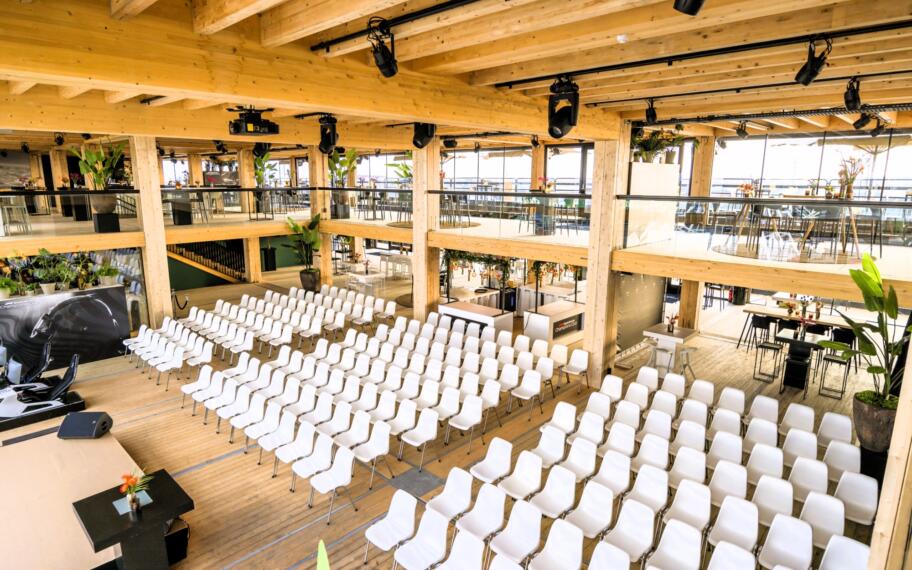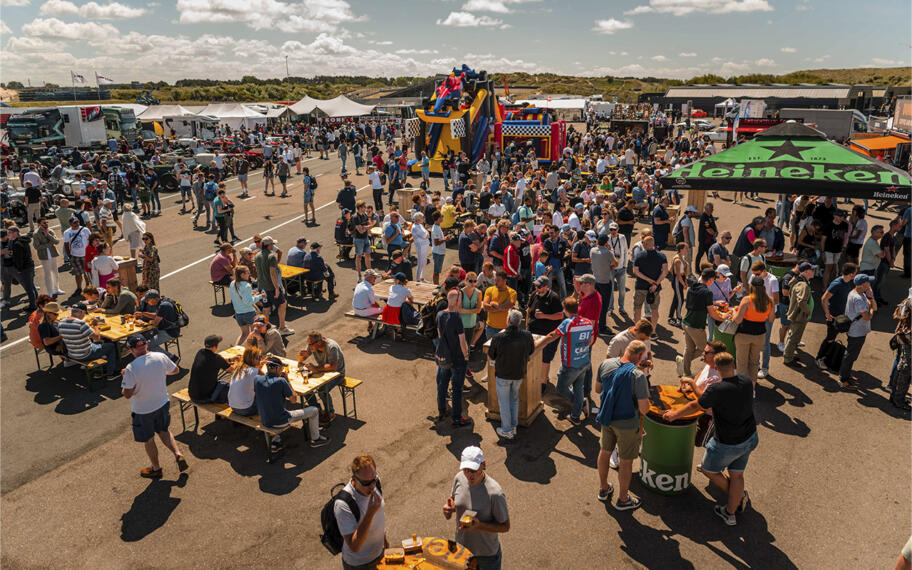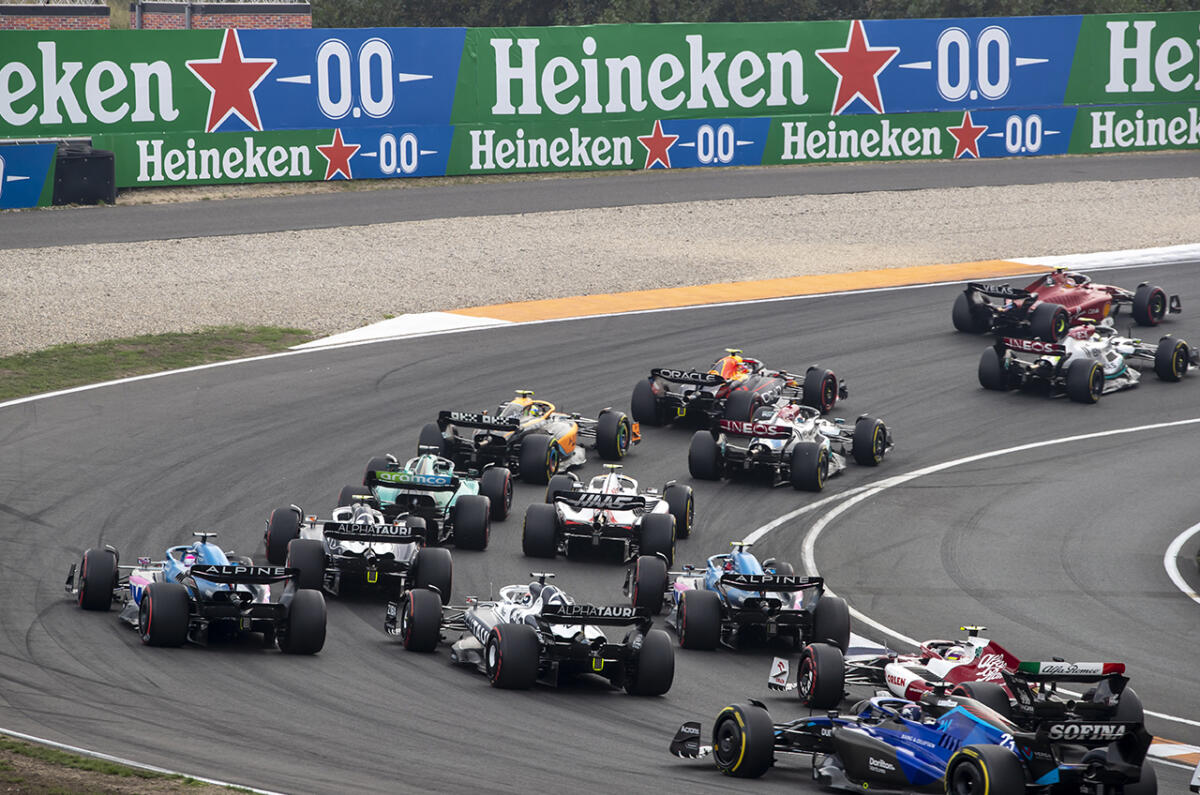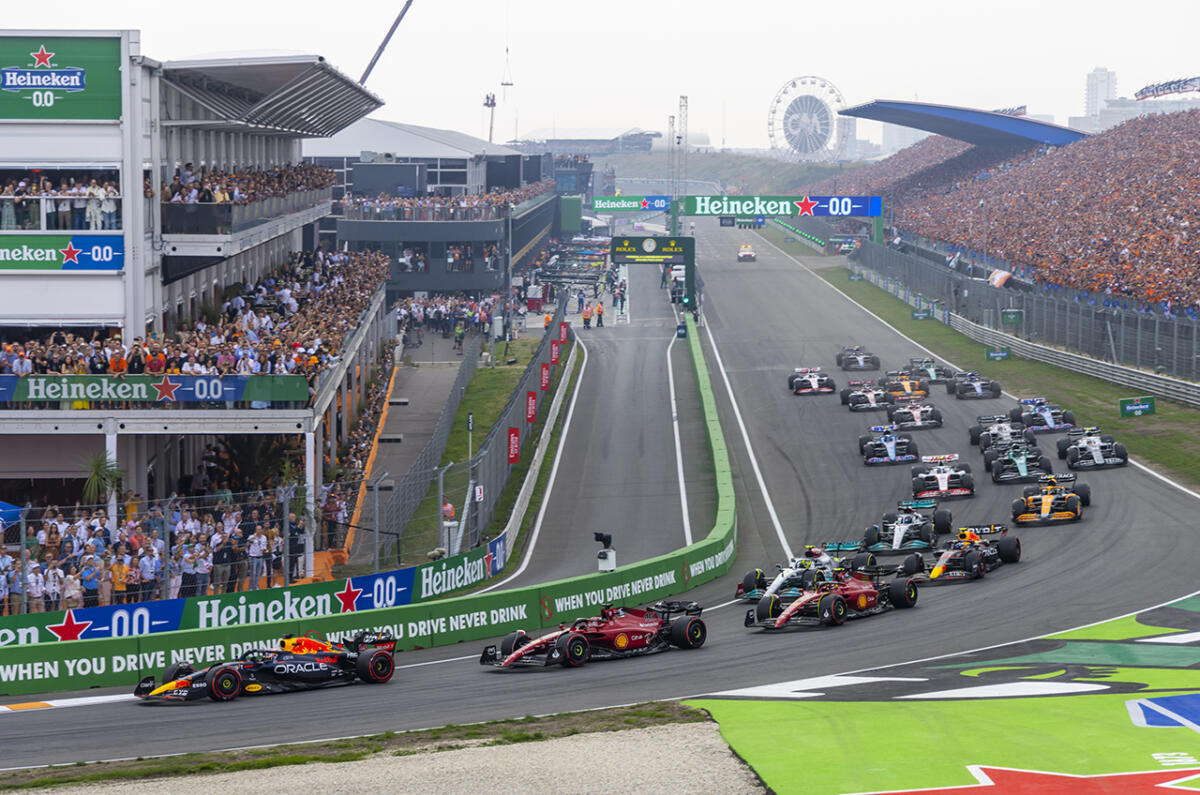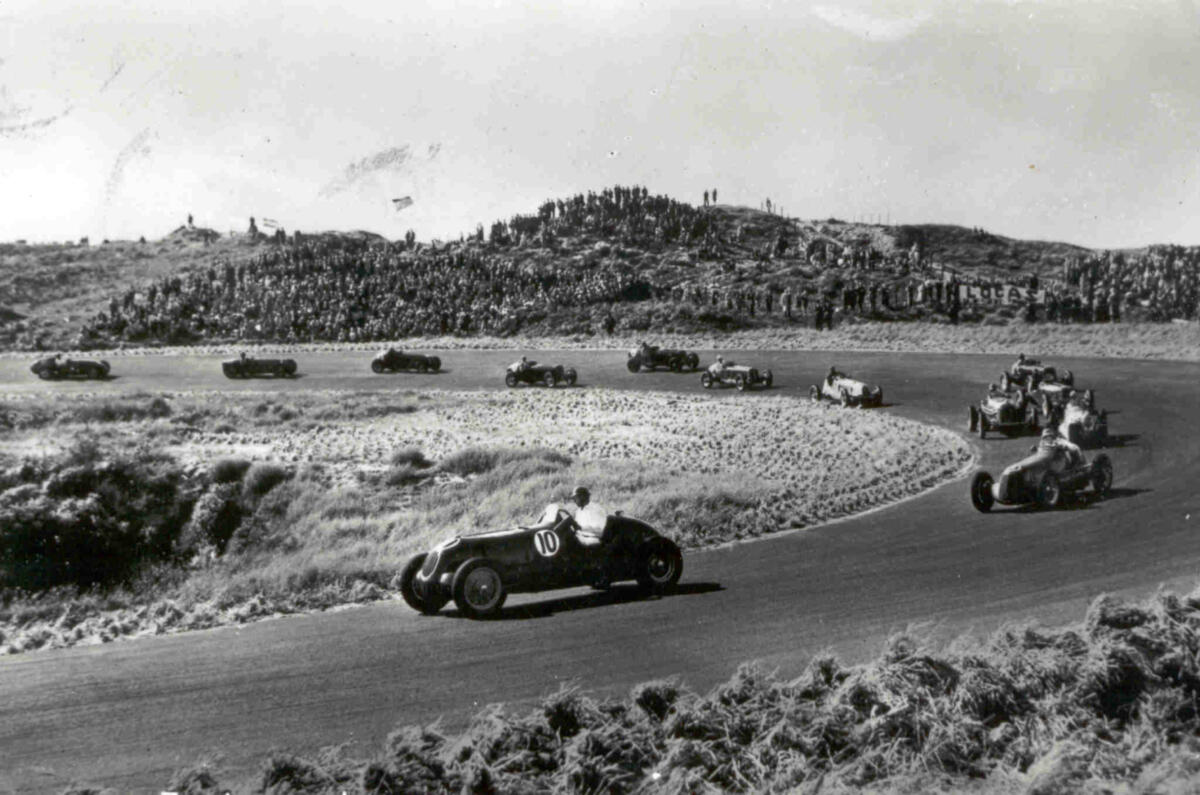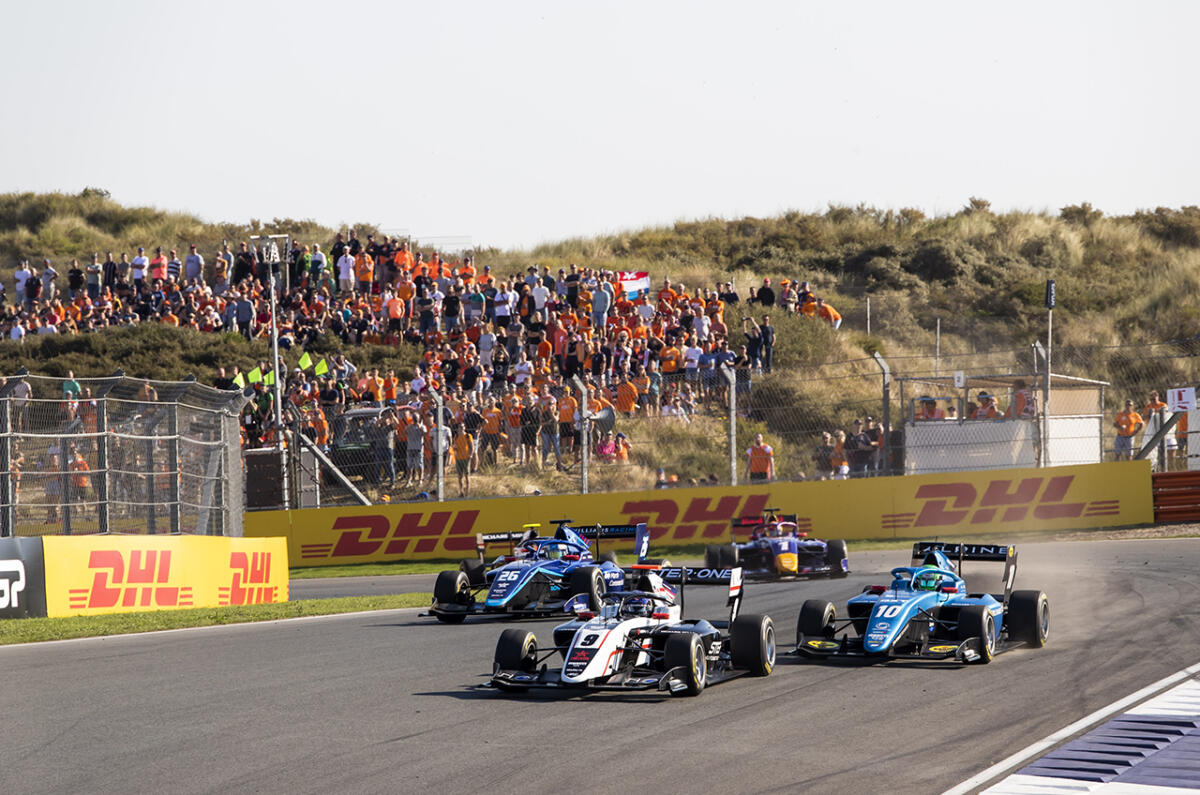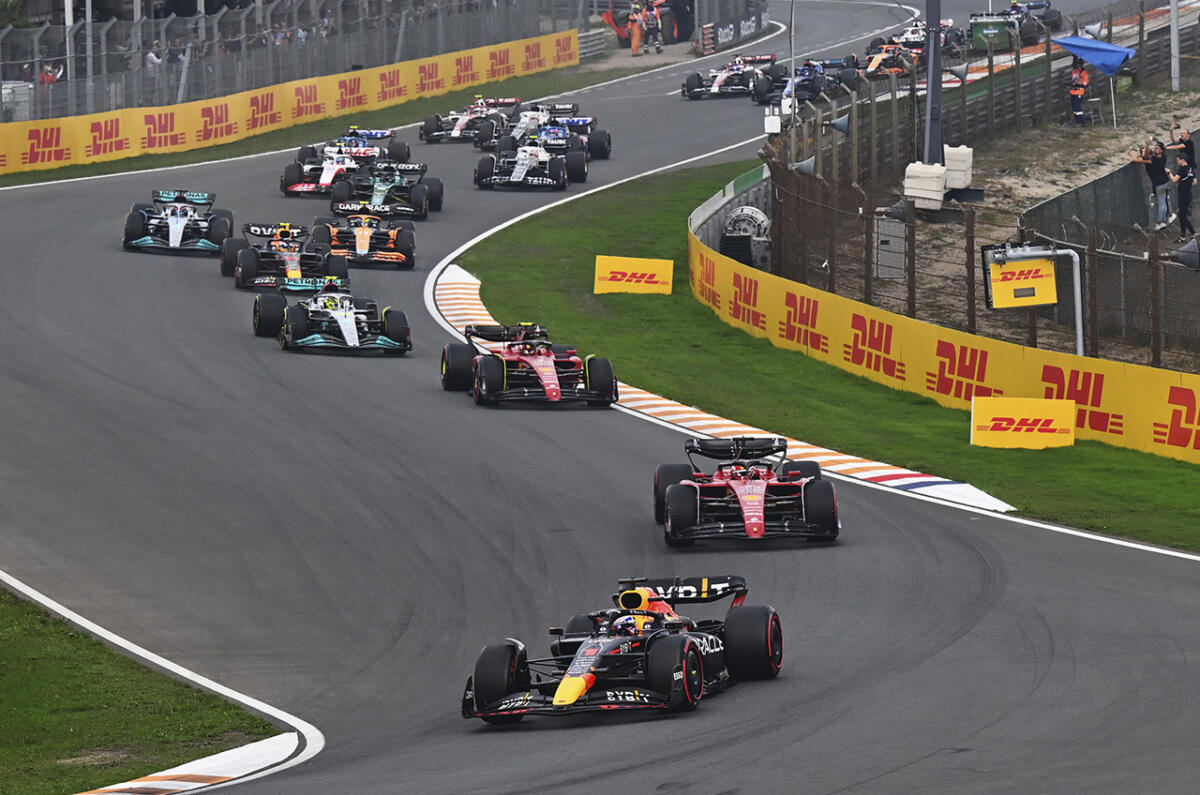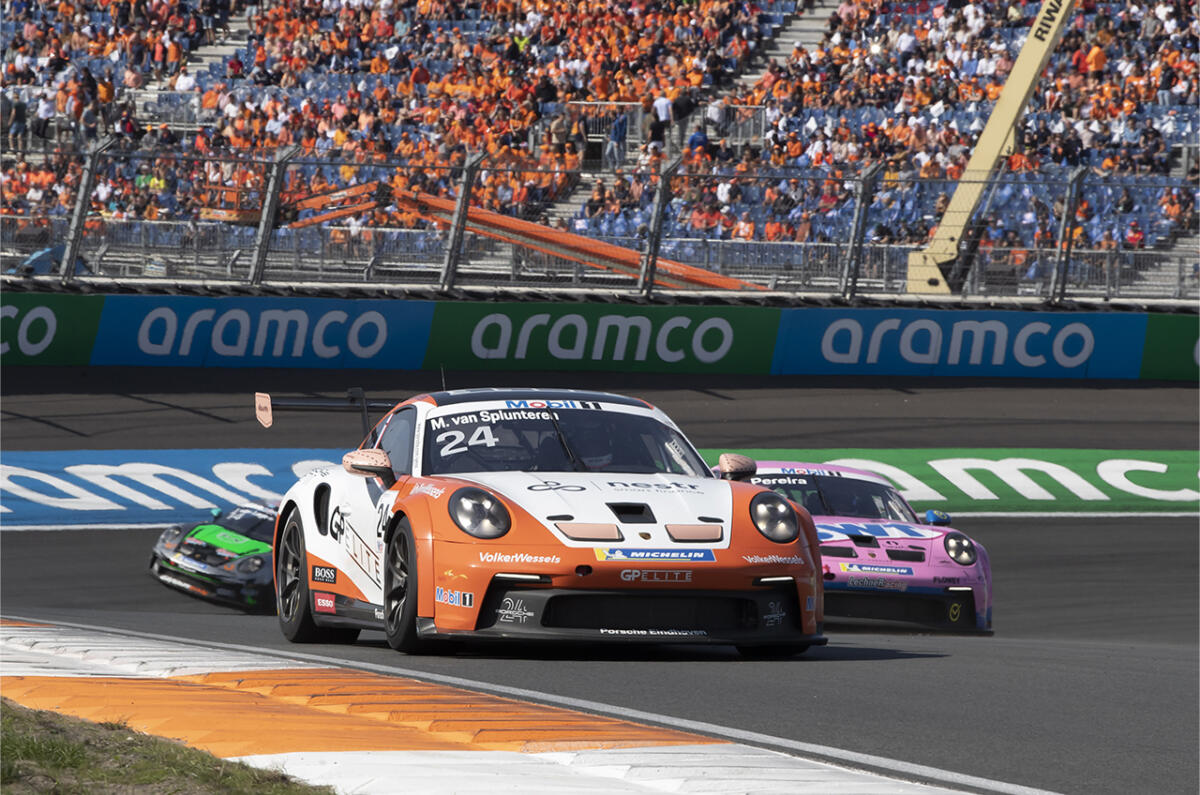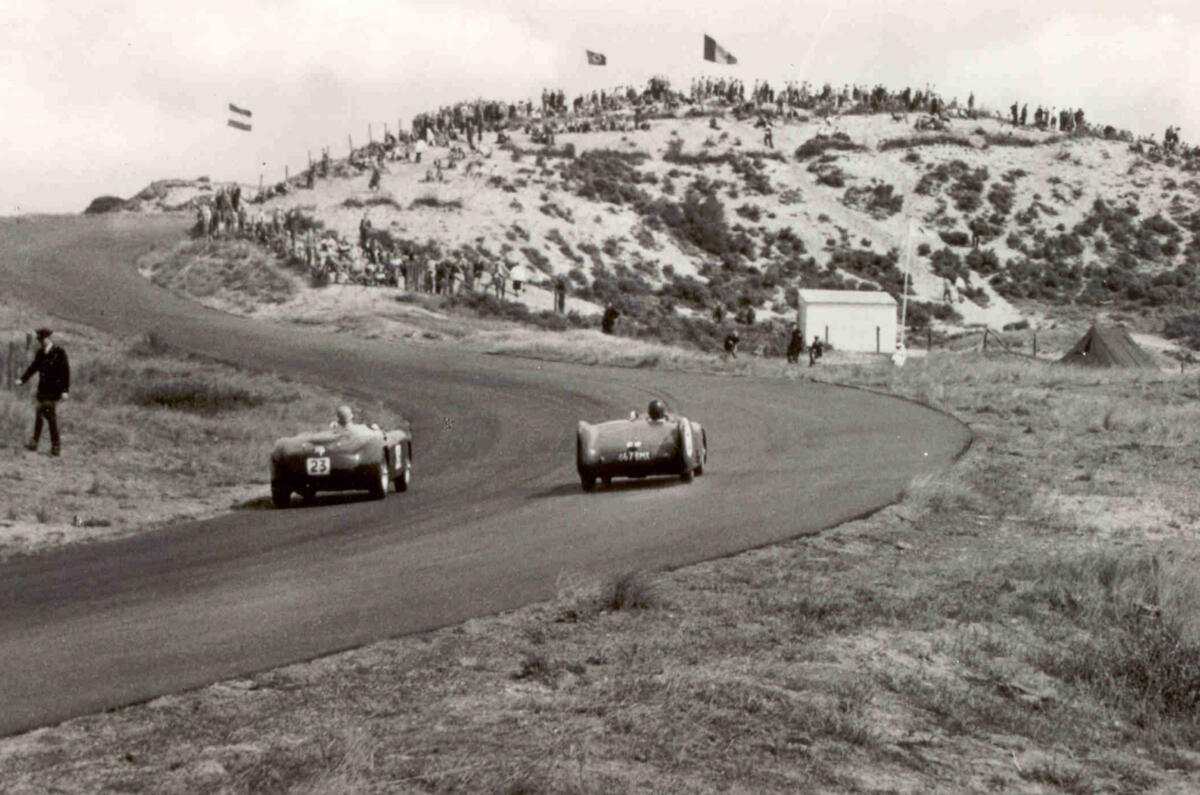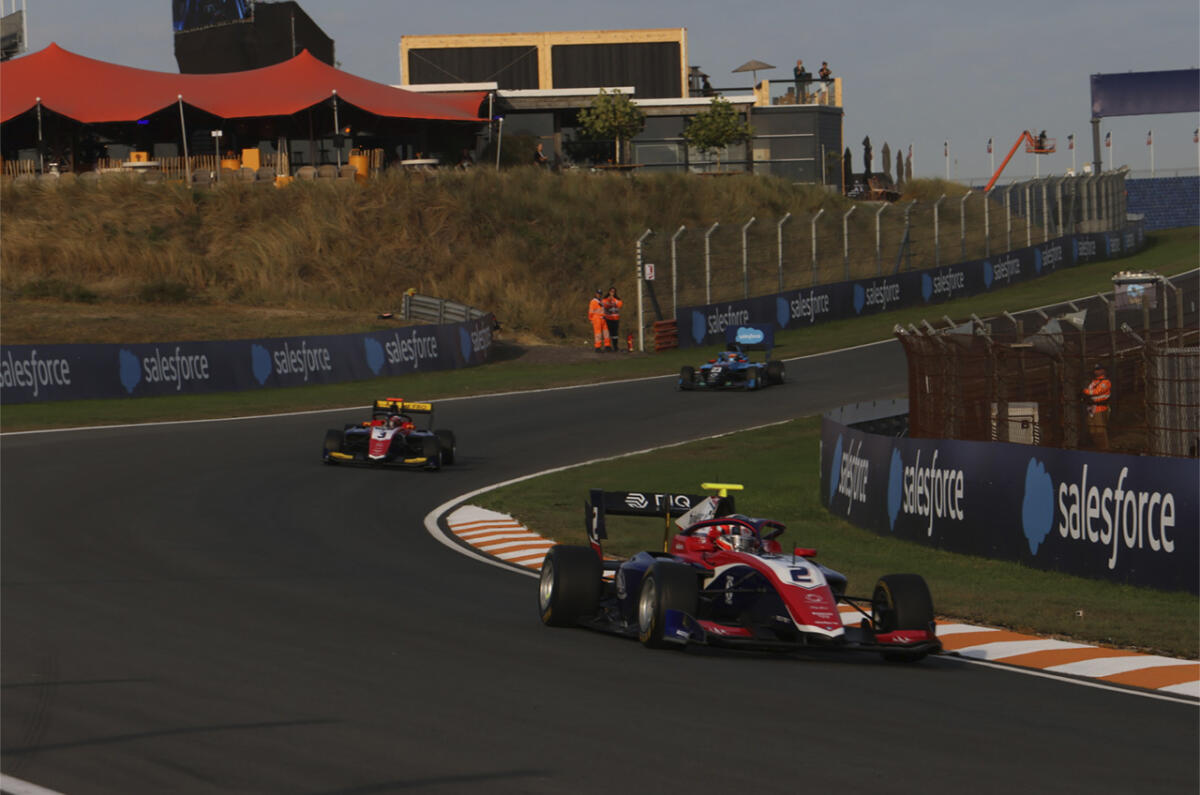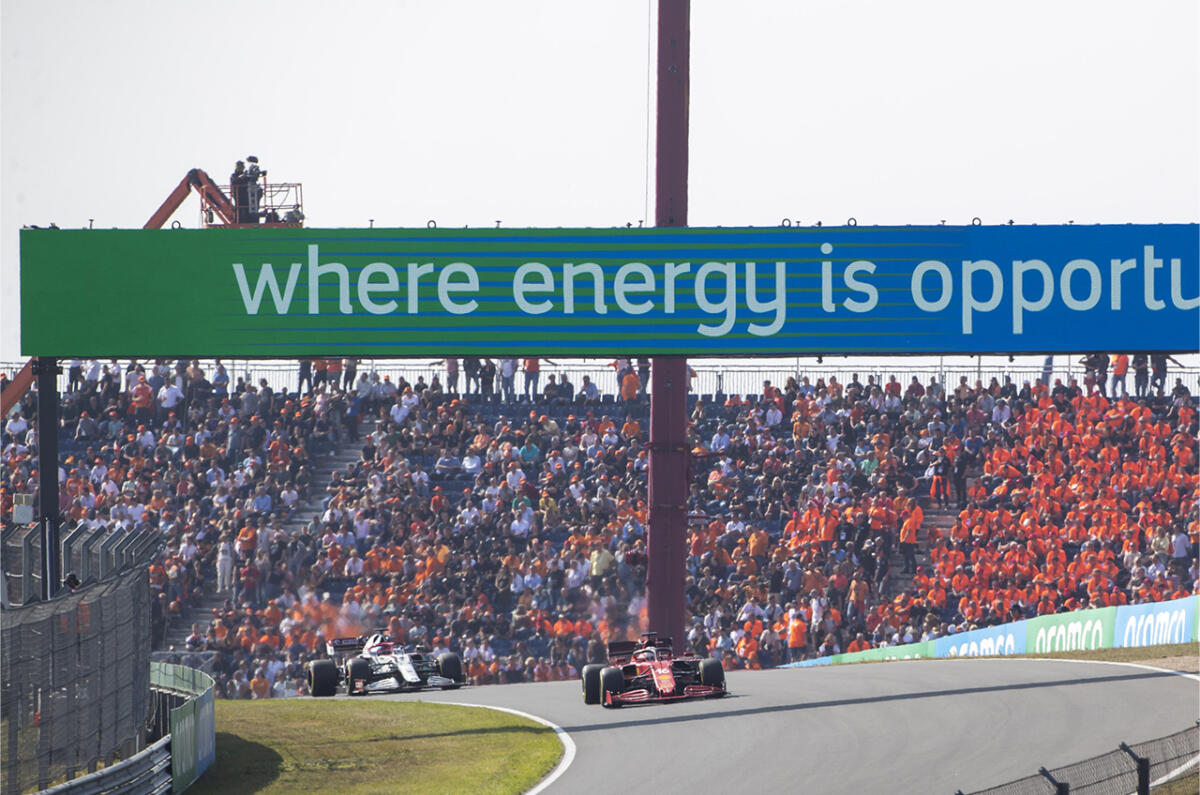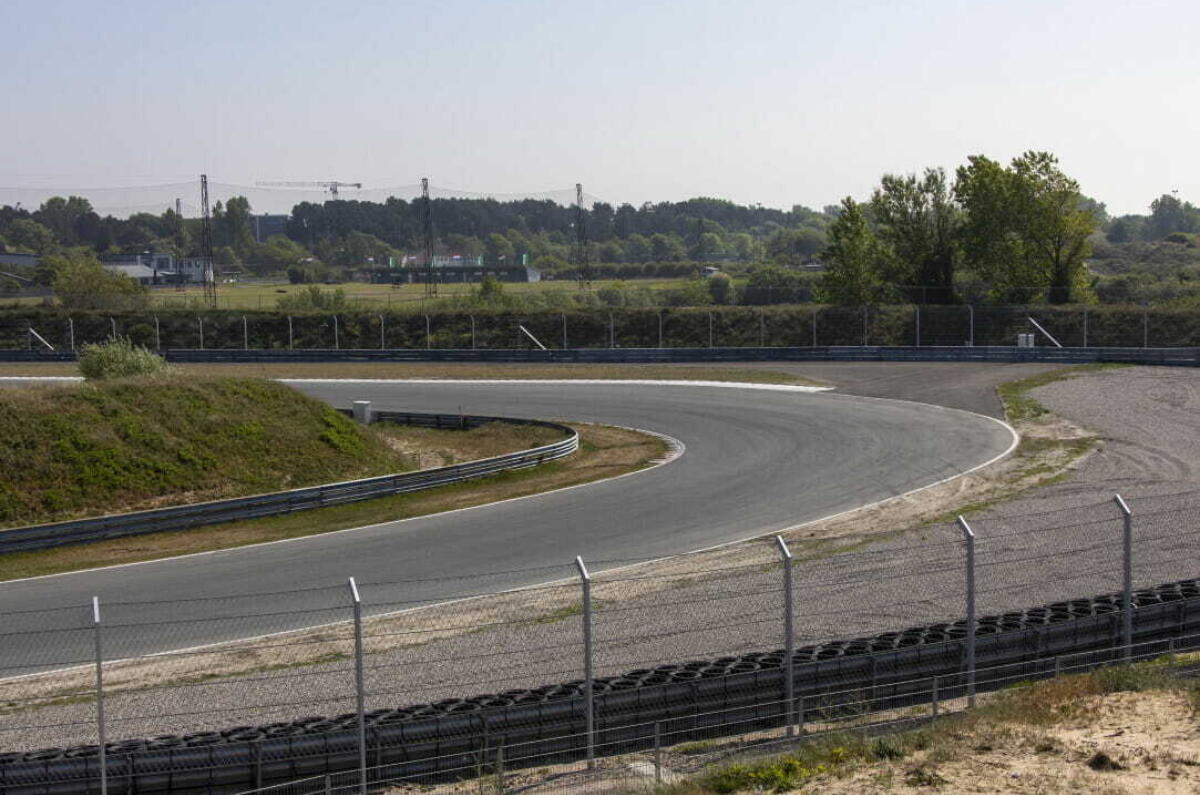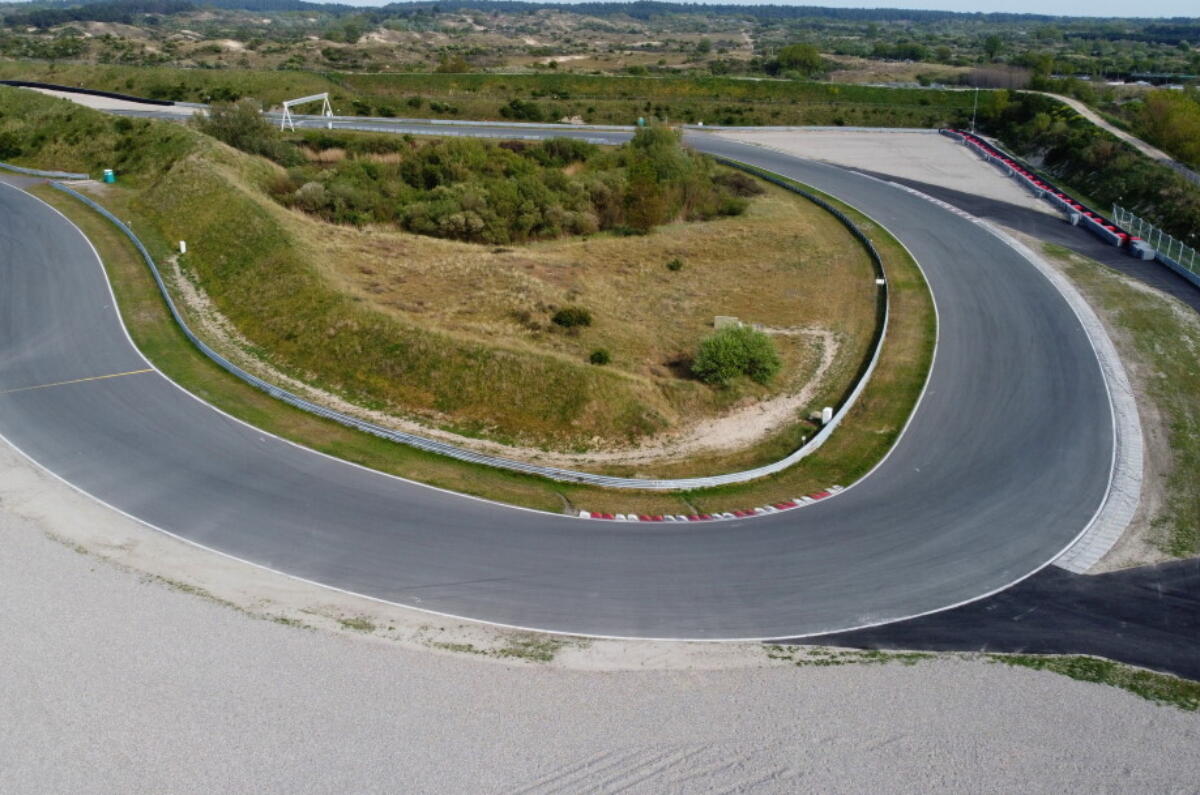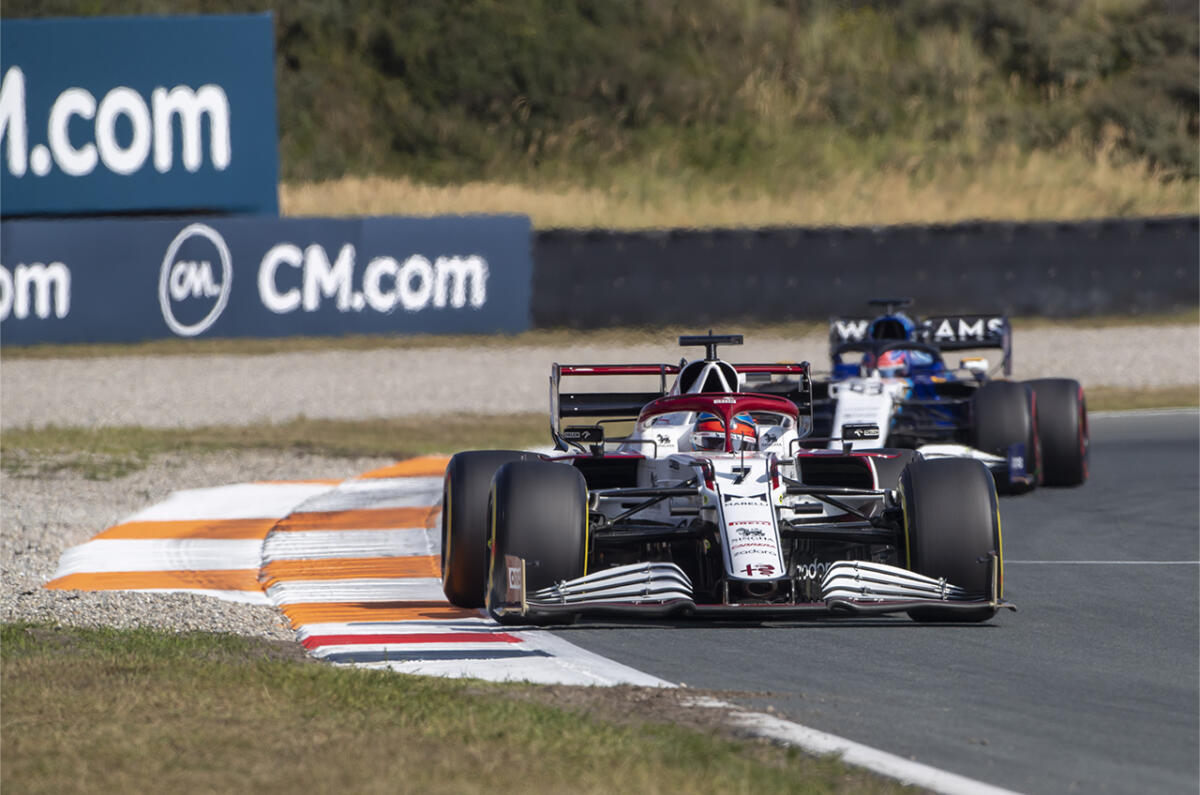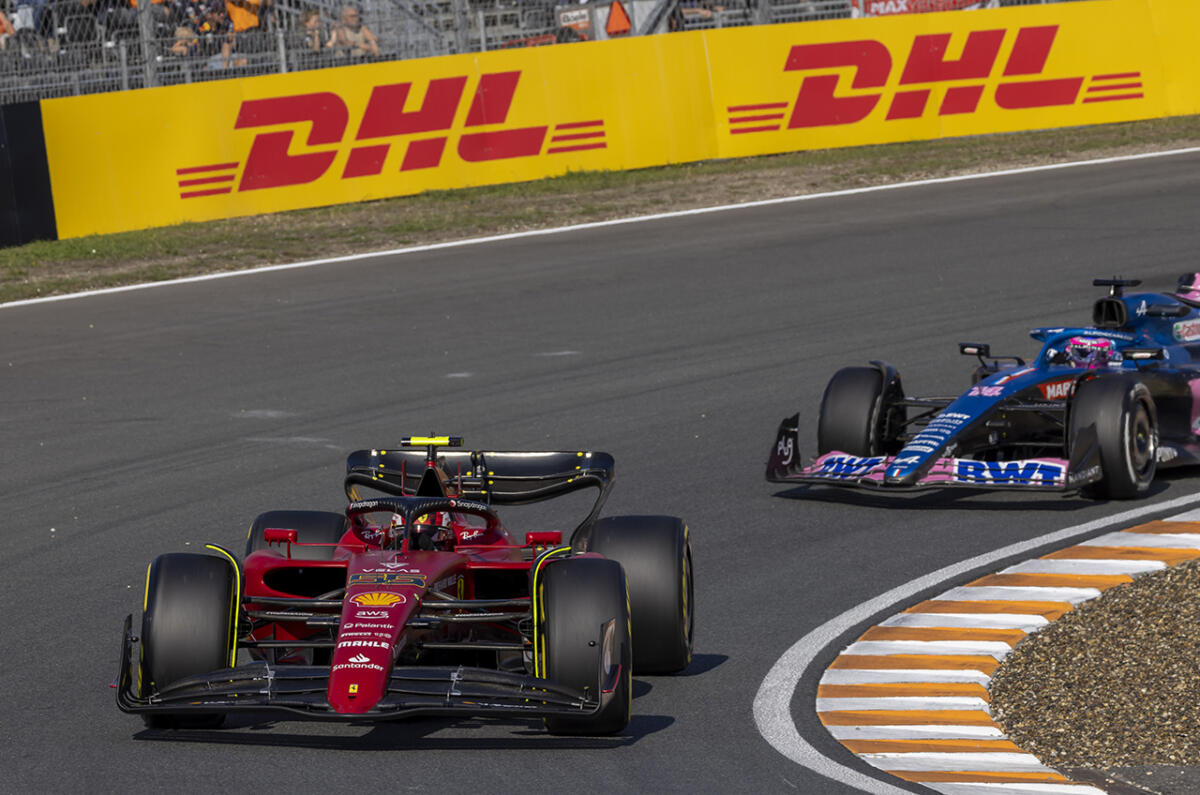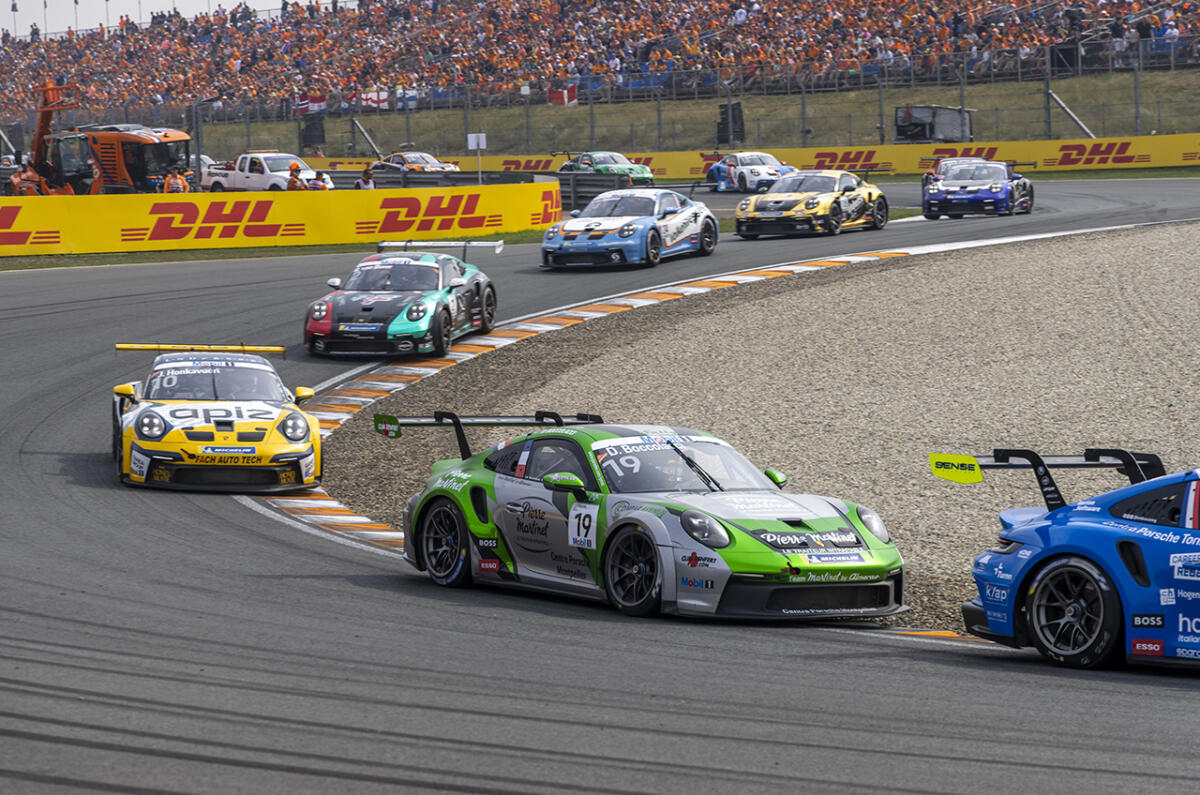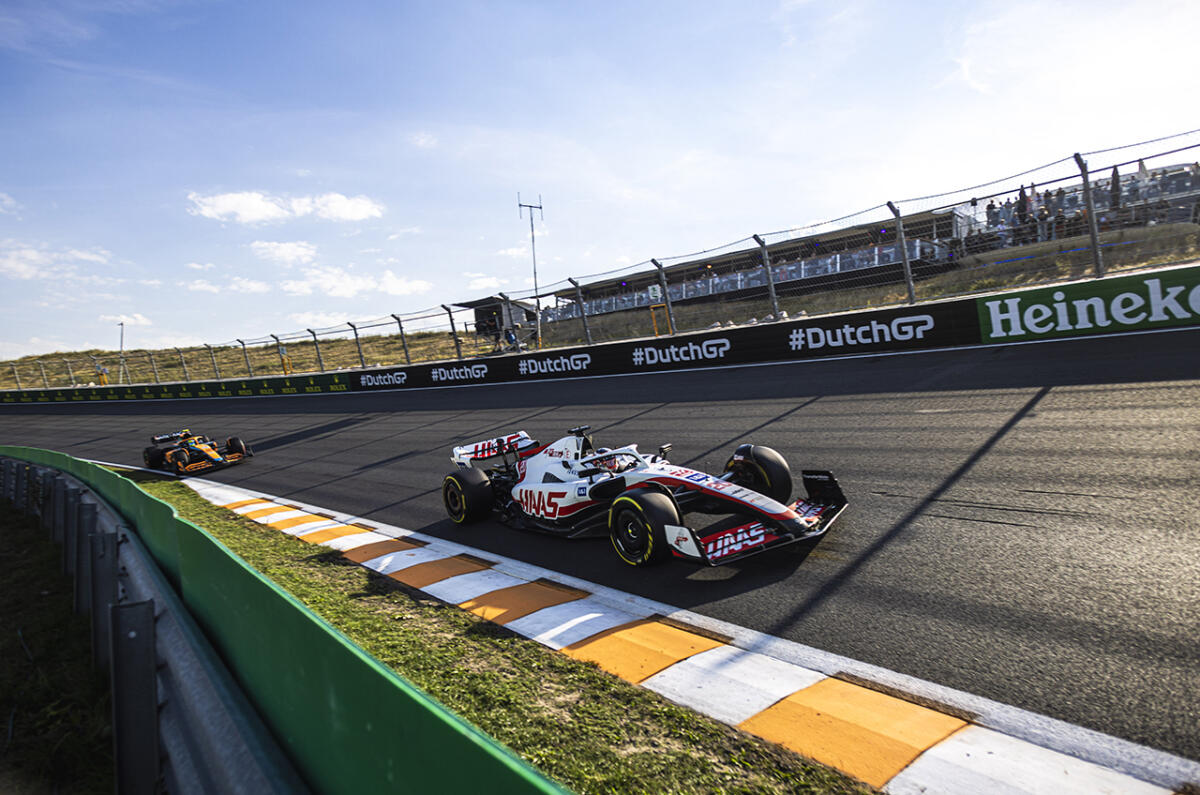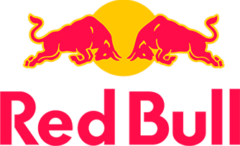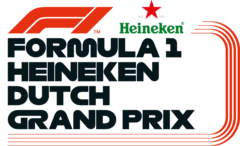Corners
1. Tarzanbocht
One of the most famous corners of Circuit Zandvoort is the Tarzanbocht. The corner has been part of the circuit route since 1948 and is located at the end of the straight. This is the corner where many spectacular overtakes, but also crashes take place because this corner offers one of the best overtaking opportunities. The drivers must fully anchor and make a 180-degree turn. Overtaking is possible here because it is a very wide corner and because of the large braking zone. Thanks to the gravel area, drivers do not exceed track limits: mistakes are immediately punished. Racing to the limit!
The Tarzanbocht has seen many changes since 1948. Where there were no crash barriers or tire stacks in the 1940s, the corner looks very different in 2020. Not only is there an asphalt run-off zone in line with the braking zone, but more tire stacks have also been placed at various locations. Also, as of 2020, the exit of the pit lane has been moved. Where it used to end at the braking zone before the corner, the exit is now at the exit of the Tarzanbocht.
2. Gerlachbocht
After defying the Tarzanbocht, the drivers quickly move towards the second turn of the circuit: the Gerlachbocht. This corner is named after Wim Gerlach. Wim Gerlach was a racing driver and died in 1957 after a crash with his Porsche Carrera Speedster. He was the first fatality on Circuit Zandvoort. There was no guard rail at the time, so when his car hooked into the loose dune sand, it rolled on.
From 2020, the corner will be wider and will have a gravel box on the left. In addition, the left side of the bend is equipped with a special 'double curb' that makes crossing track limits very uncomfortable. The corner has been part of the circuit since the early years. Although the shape of the bend has remained the same, the safety features have changed over the years. Gaining time in this corner takes guts, because the drivers have no view of the exit of the corner when entering the Gerlachbocht. The corner is therefore partly blind.
3. Hugenholtzbocht
After two turns that go right, the third corner goes left. The Hugenholtzbocht has been part of the circuit since the opening of the track in 1948. After a few years, the corner was named after the first circuit director: Hans Hugenholtz. Hans Hugenholtz was the director of the circuit in Zandvoort between 1949 and 1974. Hugenholtz designed several race tracks, such as Suzuka and part of the Hockenheimring. Sidenote: in Zandvoort, Hugenholtz was 'just' director; he didn't design the track.
Although the drivers drove into the Hugenholtz corner at a high speed, the main focus of the drivers was on the exit of the corner. This is because the most speed was generated there in the direction of Hunserug and Scheivlak. In the early years, the Hugenholtzbocht's runway barrier consisted of wooden fencing and straw bales; in the later years of tire stacks. A mild banking, where the outside of the bend was slightly higher than the inside, provided an extra challenging shape of the corner.
In 2020, not only has an asphalted run-off zone been realized on the outside of the bend, the VolkerWessels companies have also delivered a true metamorphosis here in collaboration with Dromo Circuit Design. The Hugenholtbocht has been converted into a whirling bowl bend that offers a real challenge for both rookies and experienced racers. Extra special is the progressive banking, where the outside of the turn has a higher slope than the inside. It has an angle of maximum 18 degrees, so it is not just a 'left-wing twister'. The result: different racing lines, which give a various result depending on the situation. The corner has also become wider and has been equipped with new kerbstones. Added together, the renewed elements provide a higher exit speed, which results in even more fireworks when you go up Hunserug.
4. Hunserug
After drivers discover the best racing line in the renewed Hugenholtzbocht, they speed up towards the Hunserug. The hill, with a mild but extremely fast curve to the right, was provided with new asphalt in 2020, a new track post and new FIA fences on the right. Drivers will also see the new Dutch Grand Prix Lounge at the right side of the circuit.
The Hunserug was incorporated into the design when the track was built in 1948. The idea followed in part on the instructions of Cas Hunse, involved with the KNMV, to have part of the circuit run over a ridge of dunes. Ultimately, the Hunserug would form one of the highest points of the circuit.
5. Slotemakerbocht
After the fast Hunserug, the Zandvoort “dune rollercoaster” becomes even more exciting. The route continues at high speed towards the Slotemakerbocht. Safety provisions have been adjusted at various locations here, but the challenging and unique character of Slotemakerbocht is unchanged.
The corner has been part of the circuit since the opening year in 1948. The corner was given its current name after 1979, when motorsport specialist Rob Slotemaker died in a touring car race with a Chevrolet Camaro at this location. Although the drivers came to the Slotemakerbocht at a very high speed, the main focus of the drivers is on the last part of the turn. Here you enter the next part of the circuit route almost blind. This is the part towards the famous Scheivlak. Wooden posts and wire mesh formed the division between the circuit route and public locations in 1954.
In 2022, the challenging and sloping shape of the Slotemakerbocht is still clearly visible. The 1999 chicane on the right side has been retained, for example for motorcycle training and driving activities. A new track post has been placed on the right-hand side, in accordance with FIA guidelines. Finally, at the chicane, most of the gravel pack has been replaced with grass and the last section has been paved so that minor errors at high speeds can be safely absorbed. The section towards the Scheivlak will retain its exciting and challenging characteristics.
6. & 7. Scheivlak
When drivers have reach one of the fastest locations of Circuit Zandvoort, it is time to conquer the Scheivlak. The challenging fast corner was equipped with a redesigned gravel box, new FIA fences and tire stacks in 2020. The bend remains unchanged in form and challenge.
The Scheivlak has been part of the circuit route from the first race on Circuit Zandvoort. The legendary turn started on top of a dune hill and then sloped to the right. Bearing in mind that the drivers have been driving through this at high speeds since 1948, it gives all the more meaning to the statement that many drivers made about the corner: the turn where the heroes distinguish themselves from the regular drivers.
The upgrade of Circuit Zandvoort for 2020 has also brought changes at Scheivlak. Not only has the gravel box been renewed, new FIA fences have also been placed on the left side. In addition, part of the crash barrier has been replaced by a wall, with the wall sections themselves fitted with a large number of tire stacks. The curbs have also been replaced as well as a repositioning of the track post. However, the legendary and challenging shape of the corner is unchanged and still requires that special dose of guts and skill, just like it demanded from drivers in all previous years.
8. Mastersbocht
After Scheivlak, the drivers head for turn 8, the Mastersbocht. Until the end of the 1980s, the circuit ran with a left-right combination at the exit of the Scheivlak. The first version of this left-right combination, at the Hondenvlak, had an extremely fast character. After a number of years this was judged as “too fast”, after which the Mastersbocht was built in. The corner got a slightly sharper character, so that drivers theoretically would go at a slower speed towards Tunnel East, because they had to slow down at the Mastersbocht. After the last race in the late 1980s, the section from the then Mastersbocht would no longer be used and eventually be demolished.
At the end of the 1990s, Circuit Zandvoort (and with it motorsports in the Netherlands) experienced a huge revival and, while racing on an interim circuit, it was possible to work on plans to give Circuit Zandvoort a worthy Grand Prix- length again. Within the plans, the former Slotemakerbocht and the Scheivlak were again included and linked to a new part to be developed. The circuit no longer turned left at this new section, but turned right. The new Mastersbocht would prove to be a surprising and challenging element of the renewed Circuit Zandvoort.
Even after the renovation in 2020, the Mastersbocht still poses a serious challenge for drivers, partly because of its speed character. On the inside of the kerbstones, the metal "Ludwig Teller kerbstone" has been replaced by a "sausage kerbstone", in accordance with the wishes of the FIA. At the exit of the Mastersbocht there is a new run-off area. This asphalt strip gives drivers who have lost control of their vehicle the chance to safely regain this control. Without time gain, the drivers can only rejoin at Turn 9 and continue their race. When exiting the Mastersbocht, crossing the track limits is discouraged thanks to the special double curb.
9. Turn 9
At Circuit Zandvoort, Turn 9 is a technical challenge for the drivers. After they come out of the Mastersbocht at a challenging speed, it's time to brake hard to get right into Turn 9.
Construction of the bend started in the late 1990s. After the fast part of the Scheivlak and the Masters corner, a technical corner was now built in, where drivers could overtake in different ways, but in the meantime also had to learn how to brake into the corner optimally. The flowing line at the exit of Turn 9, which for many years was known as the Renaultbocht, provided an extra attack towards Turn 10 in many duels: Turn 10.
In 2022, Turn 9 still has its interesting character. Close to the entry point, the new 'double curb' of the Mastersbocht ends and after those curbs, the escape road returns to the circuit in a safe location, without drivers being able to take advantage of it. The bend offers many opportunities to overtake, while a nice tactical game often arises in this bend. In addition, an action in Turn 9 can lead to a reaction in the next turn.
10. Turn 10
Immediately after the technical challenge of Turn 9, Turn 10 Bocht follows fairly quickly. A new 'double curb' has been in place since 2020 at the exit of the bend. The existing track post locations have also been renewed according to FIA specifications.
This corner was built in 1999 as one of the last “new turn”. The turn would ensure a connection with the already existing interim circuit, as it was realized in 1989. Turn 10, also known as Bocht Zonder Naam, Vodafone-bocht and later Turn 10 in the early years, offered a great diversity of turn-in and overtaking options from the first year. Partly because of the technical character of Turn 9, many duels are settled when entering Turn 10. If an attempt is unsuccessful when braking, it often becomes apparent when exiting the bend who is taking the most speed with them. These speed they can take along into the next corner, because there is a fast section towards the next turn.
11. & 12. Hans Ernst Chicane
Turn 11, the Hans Ernst Bocht, offers a perfect location for overtaking opponents. After all, they drive towards the corner at high speed and it is then time to brake firmly in order to correctly approach the turn. A new run-off asphalt strip was realized at the Hans Ernst Chicane at the beginning of 2020. In addition, the gravel box was renewed and new FIA fences were installed.
In 1989, the opening of the newly constructed turn was celebrated in the presence of a large number of Nissan rescue vehicles. The bend was therefore christened Nissanbocht, a name that would keep the bend long. In recent years, the corner has been known as Hans Ernst Chicane, named after the previous circuit director Hans Ernst, who put Circuit Zandvoort on the international map again from the 1990s onward and contributed to the iconic status that the circuit has today.
In 2020, the Hans Ernst Chicane is still a spectacular location for overtaking. Cutting the corner does not provide any advantage due to the new sausage curb, because the car becomes unbalanced. When drivers experience braking problems, they can use the asphalt run-off area in line with the braking zone. The second part of the Hans Ernst Chicane has also become wider, so that more different racing lines can be driven.
13. Turn 13
For many drivers, Turn 13 at Circuit Zandvoort will be an important element of the race lap. After all, the speed at the exit of this corner is of great importance for the ultimate top speed in the Arie Luyendykbocht and the chance of a slipstream. Turn 13 has new asphalt and new safety features.
Since the turn was built in 1989, it has become apparent that the turn offers interesting opportunities for overtaking. However, not every opportunity is taken, as drivers mainly focus on achieving high speed at the exit of Turn 13 and thereby creating a greater chance for a slipstream and overtaking action on the straight.
In 2022, Turn 13 is still important for the drivers, with the exit of the corner determining both speed and lap time. The turn will be fitted with the new Flying Dutch-asphalt in February 2022. The gravel pit has been updated, while new FIA fencing has been installed on both sides of the bend. Tire stacks have been placed on the outside of the bend and Tecpro barriers have been placed at the location where a high-speed incident can take place. New kerbstones have been placed both on the inside and at the exit of the turn. In the case of the exit from the corner, it is a double curb where crossing track limits is not attractive.
14. Arie Luyendykbocht
Immediately after the important Turn 13, the last corner of Circuit Zandvoort soon follows: the Arie Luyendykbocht. The corner is named after the two-time winner of the prestigious Indianapolis 500. The corner underwent a major metamorphosis in 2020 and was eventually transformed into an impressive banked corner with a banking of 18 degrees, including a SAFER barrier.
The turn was created in 1948 in an area between a large pond and a collection of potato lands called 'Pulleveld.' The bend was named 'Bos Uit' because the drivers approached the last bend out of a small forest. Provided that the drivers would enter the corner in the right way, they could reach very high speeds at the then Bos Uit, and then take that high speed with them onto the long straight.
At the end of the 1980s, the Circuit Zandvoort was heavily converted and shortened to an interim circuit. A bungalow park was realized at the location of what was then Bos Uit. As a result, the last corner was at a different location, but he kept the name Bos Uit. In 2001, the name of the corner would change to Arie Luyendykbocht, in tribute to the two-time Indy 500 winner.
In 2020, the Arie Luyendykbocht changed a lot. Not only the gravel box disappeared, but also the turn itself was transformed into an impressive banked corner. The Arie Luyendykbocht makes it possible to race towards the finish line and Tarzanbocht at a higher speed, thanks to a 15-18 degree slope (a maximum gradient of 32%) in the banked corner. This will also increase the number of slipstream battles on the straight and overtakes at the Tarzanbocht. Thanks to the combination of a closed steel guardrail construction with special foam elements, the SAFER barrier absorbs the energy released during a crash. The forces and energy that a driver still experiences during this are considerably lower than in previous incidents. The closed construction also ensures that the damaged cars can slide on towards a safer location at the end of the corner.



